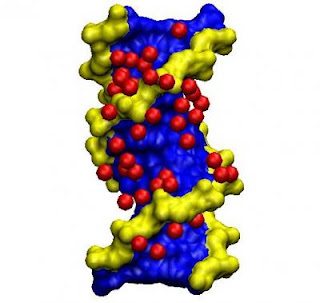Water molecules surround the genetic material DNA in a very specific way. Scientists at the Helmholtz-Zentrum Dresden-Rossendorf (HZDR) have discovered that, on the one hand, the texture of this hydration shell depends on the water content and, on the other hand, actually influences the structure of the genetic substance itself. These findings are not only important in understanding the biological function of DNA; they could also be used for the construction of new DNA-based materials.
The DNA's double helix never occurs in isolation; instead, its entire surface is always covered by water molecules which attach themselves with the help of hydrogen bonds. But the DNA does not bind all molecules the same way. "We've been able to verify that some of the water is bound stronger whereas other molecules are less so," notes Dr. Karim Fahmy, Head of the Biophysics Division at the Institute of Radiochemistry. This is, however, only true if the water content is low. When the water sheath swells, these differences are adjusted and all hydrogen bonds become equally strong. This, in turn, changes the geometry of the DNA strand: The backbone of the double helix, which consists of sugar and phosphate groups, bends slightly. "The precise DNA structure depends on the specific amount of water surrounding the molecule," summarizes Dr. Fahmy.
"DNA is, thus, a responsive material," explains Karim Fahmy. "By this, we refer to materials which react dynamically to varying conditions. The double helix structure, the strength of the hydrogen bonds, and even the DNA volume tend to change with higher water contents." Already today, genetic material is an extraordinarily versatile and interesting molecule for so-called DNA nanotechnology. Because with DNA it is possible to realize highly ordered structures with new optical, electronic, and mechanical properties at tiny dimensions which are also of interest for the HZDR. The bound water sheath is not just an integral part of such structures. It can also assume a precise switching function because the results indicate that increasing the hydration shell by only two water molecules per phosphate group may cause the DNA structure to "fold" instantly. Such water dependent switching processes might be able to control, for example, the release of active agents from DNA-based materials.
It does not come as a complete surprise that the water sheath of the genetic material is also of great relevance to the natural biological function of DNA. Because every biomolecule which is bound to the DNA has to first displace the water sheath. The Dresden scientists have analyzed this process for the peptide indolicidin. This antimicrobial protein is less structured and very flexible. That it still "identifies" the double helix so precisely is due to the fact that highly structured water molecules are released when it coalesces with the genetic material. The water sheath's restructuring, which is actually an energetic advantage, increases the binding of the active agent. Such details are really important for the development of DNA-binding drugs, for example, in cancer therapy because they can be ascertained with the method developed at the HZDR.
###
Contact: Dr. Christine Bohnet c.bohnet@hzdr.de 49-351-260-2450 Helmholtz Association of German Research Centres












No comments:
Post a Comment